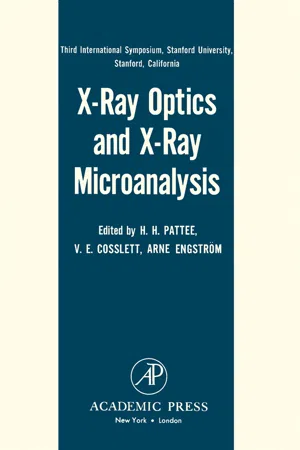
X-Ray Optics and X-Ray Microanalysis
- 640 pages
- English
- PDF
- Available on iOS & Android
X-Ray Optics and X-Ray Microanalysis
About this book
X-ray Optics and X-ray Microanalysis covers the proceedings of the Symposium on X-ray Optics and X-ray Microanalysis, held at Stanford University on August 22-24, 1962. The book focuses on X-ray microscopy, microradiography, radiation and irradiation, and X-ray microanalysis. The selection first offers information on the methods of X-ray microscopy and X-ray absorption microanalysis. Discussions focus on X-ray scanning microscopy, contact microradiography, point projection microscopy, and total dry-weight determinations. The text then takes a look at X-ray microanalysis in biology and medicine; electron microscopic enlargements of X-ray absorption micrographs; and automation in microradiography. The publication examines the production of Fresnel zone plates for extreme ultraviolet and soft X radiation; quantitative microradiographic studies of human epidermis; and irradiation effect on total organic nerve-cell material determined by integrating X-ray absorption. The manuscript then reviews the calculation of fluorescence excited by characteristic radiation in the X-ray microanalyzer and the method for calculating the absorption correction in electron-probe microanalysis. The selection is a valuable reference for readers interested in X-ray technology.
Frequently asked questions
- Essential is ideal for learners and professionals who enjoy exploring a wide range of subjects. Access the Essential Library with 800,000+ trusted titles and best-sellers across business, personal growth, and the humanities. Includes unlimited reading time and Standard Read Aloud voice.
- Complete: Perfect for advanced learners and researchers needing full, unrestricted access. Unlock 1.4M+ books across hundreds of subjects, including academic and specialized titles. The Complete Plan also includes advanced features like Premium Read Aloud and Research Assistant.
Please note we cannot support devices running on iOS 13 and Android 7 or earlier. Learn more about using the app.
Information
Table of contents
- Front Cover
- X-Ray Optics and X-Ray Microanalysis
- Copyright Page
- Table of Contents
- List of Contributors
- Preface
- Chapter 1. Methods of X-Ray Microscopy
- Chapter 2. X-Ray Absorption Microanalysis
- Chapter 3. X-Ray Microanalysis in Biology and Medicine
- Chapter 4. Electron Microscopic Enlargements of X-Ray Absorption Micrographs
- Chapter 5. Automation in Microradiography
- Chapter 6. Contrast-Controlled Reproduction and Enlargement of Microradiographic Negatives
- Chapter 7. Production of Fresnel Zone Plates for Extreme Ultraviolet and Soft X Radiation
- Chapter 8. Recent Developments in Field Emission Flash Radiography
- Chapter 9. Quantitative Microradiographic Studies of Human Epidermis
- Chapter 10. Irradiation Effect on Total Organic Nerve-Cell Material Determined by Integrating X-Ray Absorption
- Chapter 11. Histochemical X-Ray Absorption Measurement of Lipid in the Adrenal Gland of the Rat
- Chapter 12. X-Ray Microscopy of the Microvascular System of the Human Lung
- Chapter 13. Microangiography in Living Human Subject
- Chapter 14. Some Mineralogical and Technical Applications of Contact Microradiography with Fluorescent X Rays
- Chapter 15. Small-Angle X-Ray Scattering on an Absolute Scale
- Chapter 16. Production, Detection, and Application of Ultrasoft X Rays
- Chapter 17. The Spectral Distribution of the Radiation from a Microfocus X-Ray Tube with a Membrane Target
- Chapter 18. The Efficiency of Production of Characteristic X Radiation
- Chapter 19. An Efficient Spectrograph for the Study of X-Ray Spectra in the Range of 0.7 A
- Chapter 20. Optical Techniques Applied to the Study of X-Ray Wavelengths
- Chapter 21. Effects of Polishing Imperfections on Specular Reflection of X Rays
- Chapter 22. Reflectance Measurements at Carbon-K and Beryllium-K Wavelengths
- Chapter 23. Substratum Influence on the Reflectance of Aluminum Vacuum-Deposited Films for X Rays
- Chapter 24. Grazing-lncidence Telescopic Systems
- Chapter 25. X-Ray Microdiffraction in X-Ray Scanning Microanalysis
- Chapter 26. X-Ray Microprobe Techniques
- Chapter 27. The Application of the Electron-Probe Microanalyzer to Metallurgy and Mineralogy
- Chapter 28. Review of Microanalysis in Japan
- Chapter 29. Electron-Probe Measurements near Phase Boundaries
- Chapter 30. Calculation of Fluorescence Excited by Characteristic Radiation in the X-Ray Microanalyzer
- Chapter 31. A Suggested Secondary Fluorescence Correction Technique for Electron-Probe Analyses in the Vicinity of a Steep Concentration Gradient
- Chapter 32. The Target Absorption Correction in X-Ray Microanalysis
- Chapter 33. A Method for Calculating the Absorption Correction in Electron-Probe Microanalysis
- Chapter 34. The Effect of Atomic Number in X-Ray Microanalysis
- Chapter 35. Atomic Number Effects in Microprobe Analysis
- Chapter 36. Scattering of Electrons from a Microanalyzer Target
- Chapter 37. X-Ray Microanalysis of Elements in the Range Z=4–92, Combined with Electron Microscopy and Electron Diffraction
- Chapter 38. An Experimental Electron Optical Bench for Electron Microscopy and X-Ray Microanalysis
- Chapter 39. X-Ray Fluorescence Analysis with a Focused Primary Beam
- Chapter 40. The Use of Specimen Current in Electron-Probe Microanalysis
- Chapter 41. On a New Electron-Probe X-Ray Microanalyzer having a 90° Take-Off Angle
- Chapter 42. An X-Ray Microanalyzer for Elements of Low Atomic Number
- Chapter 43. A Consideration of Some Design Features of a Scanning Microanalyzer for Biological Applications
- Chapter 44. Problems Associated with the Preparation of Biological Specimens for Microanalysis
- Chapter 45. Some Biological Applications of the Scanning Microanalyzer
- Chapter 46. X-Ray Fluorescence Microanalysis and the Determination of Potassium in Nerve Cells
- Chapter 47. X-Ray Fluorescence Spectroscopy in Biology and Medicine
- Chapter 48. Electron-Probe Microanalysis of Biological Specimens
- Chapter 49. Analysis of Heavy Elements (Z>80) with the Castaing Microprobe: Application to the Analysis of Binary Systems Containing Uranium
- Chapter 50. A Study of Microsegregation at Grain Boundaries in Mild Steel by Means of the Electron–Probe Microanalyzer
- Chapter 51. The Use of the Electron-Microprobe Analyzer in the Study of Binary Metal Alloy Systems
- Chapter 52. Sensitivity of X-Ray Spectrochemical Analysis of Steels by Electron Excitation
- Chapter 53. Electron-Probe Analysis of Minerals in the System FeS2-CoS2-NiS2
- Subject Index